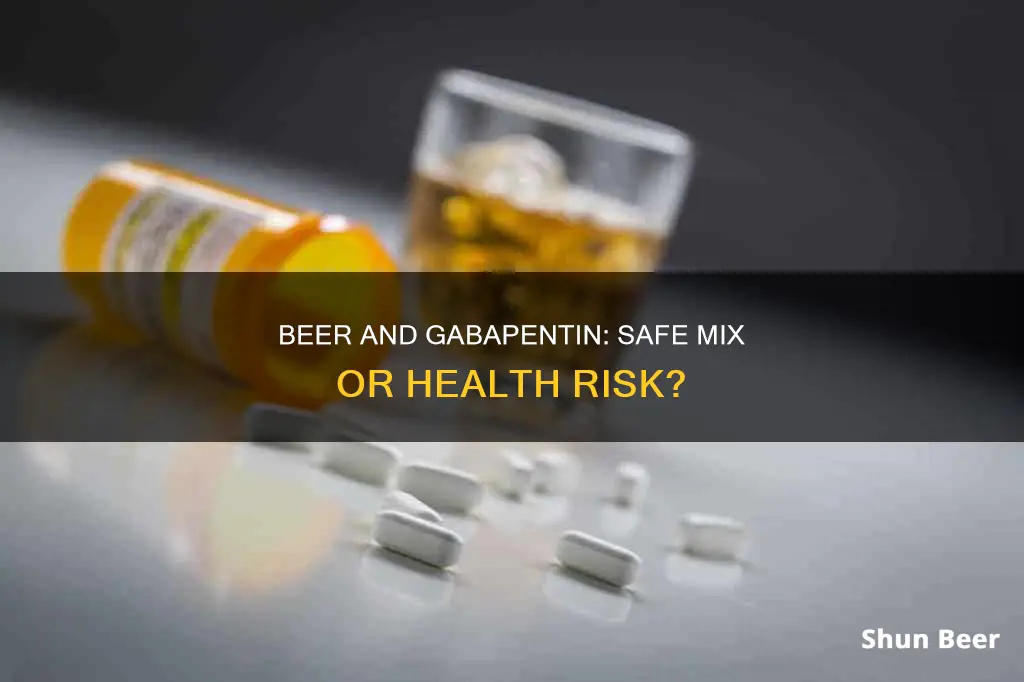
Gabapentin is a prescription drug used to treat nerve pain, nerve damage, seizures, and alcohol withdrawal. It is occasionally prescribed to help people stop drinking. While it is possible to consume small amounts of alcohol while taking gabapentin, it is generally advised to avoid or limit alcohol consumption while on this medication. This is because alcohol can increase the nervous system side effects of gabapentin, such as dizziness, drowsiness, and difficulty concentrating. Mixing the two substances can also lead to impaired thinking and judgment, and an increased risk of injury from falls. Therefore, it is recommended to consult a doctor or pharmacist before consuming alcohol while taking gabapentin to ensure safe usage and avoid potential adverse effects.
| Characteristics | Values |
|---|---|
| Should I drink beer while taking gabapentin? | Drinking while taking gabapentin should be avoided as it can increase the risk of side effects such as dizziness, drowsiness, difficulty concentrating, impaired thinking and judgment, nausea, vomiting, memory loss, and headaches. |
| Why is it dangerous to drink beer while taking gabapentin? | Alcohol can increase the nervous system side effects of gabapentin. |
| What should I do if I want to drink beer while taking gabapentin? | Talk to your doctor before drinking any alcohol while taking gabapentin. Do not drink more than the recommended amount of alcohol and avoid activities that require mental alertness, such as driving or operating machinery. |
What You'll Learn

Gabapentin's effect on the nervous system
Gabapentin is a prescription drug commonly used to treat nerve pain, control seizures, and relieve postherpetic neuralgia after shingles. It is also used to treat restless leg syndrome and diabetic neuropathy. It is available in tablet, capsule, and oral solution forms and can be taken with or without food.
Gabapentin is a central nervous system depressant and a gamma-aminobutyric acid (GABA) analogue. GABA is a neurotransmitter that reduces the excitability of nerve cells (neurons) in the brain, which play a role in seizures and the transmission of pain signals. By mimicking the effects of GABA, gabapentin helps to calm excited neurons.
The effects of gabapentin on the nervous system can include:
- Dizziness
- Drowsiness
- Difficulty concentrating
- Loss of coordination
- Blurred/double vision
- Unusual eye movements
- Mood changes
- Thoughts of suicide and depression
- Nausea and vomiting
- Difficulty speaking
- Recurring infections
- Movement problems
When combined with alcohol, the nervous system side effects of gabapentin can be amplified. Alcohol is also a central nervous system depressant, so consuming it while taking gabapentin can increase the risk of adverse effects such as dizziness, drowsiness, and difficulty concentrating. Some people may also experience impaired thinking and judgment. Therefore, it is generally recommended to avoid or limit alcohol consumption while taking gabapentin.
Beer and Prediabetes: What's the Verdict?
You may want to see also

Alcohol's impact on gabapentin side effects
Alcohol can increase the nervous system side effects of gabapentin, such as dizziness, drowsiness, and difficulty concentrating. People who mix the two substances may also experience impaired thinking and judgment.
Gabapentin is a central nervous system depressant sometimes sold under brand names like Gralise, Horizant, and Neurontin. It is a prescription drug commonly used to treat nerve pain, seizures, nerve damage in shingles patients, and epilepsy.
Alcohol is a legal sedative that changes how we feel. It falls into the class of drugs known as depressants, which are also generalized as psychoactive drugs. Psychoactive drugs affect the mind or mental processes.
When used together, alcohol and gabapentin can increase the effects of each other. This means that the combination is likely to affect you adversely. For this reason, it is not recommended to drink and take this drug. Doctors advise limiting alcohol use while being treated with gabapentin.
The side effects of mixing alcohol and gabapentin include:
- Loss of coordination
- Impaired thinking and judgment
- Headaches
- Nausea
- Anxiety
- Increased potency of each substance
- Euphoria
- Calmness
- Sociability
In addition, heavy drinkers may experience:
- Loss of coordination
- Nausea
- Vomiting
- Memory loss
- Drowsiness
Mixing alcohol and gabapentin can be dangerous due to the risk of injury from falls. It is important to avoid activities requiring balance or mental alertness, such as driving or operating hazardous machinery, when taking this combination.
Beer and Plavix: Safe Mix or Health Risk?
You may want to see also

Potential dangers of mixing the two
While it may be safe to consume small amounts of alcohol while taking gabapentin, mixing the two substances can be dangerous.
Firstly, alcohol can increase the nervous system side effects of gabapentin, such as dizziness, drowsiness, and difficulty concentrating. This means that the combination of the two may impair your thinking and judgment. As a result, you should avoid activities requiring mental alertness, such as driving or operating machinery, after drinking alcohol while taking gabapentin.
Secondly, gabapentin and alcohol can increase each other's potency when mixed. This substance interaction can lead to a higher risk of adverse effects, such as nausea, vomiting, headaches, and anxiety. Additionally, the combination may increase the likelihood of injury from falls due to loss of coordination.
Thirdly, gabapentin is a prescription drug that can be abused, and mixing it with alcohol could worsen the potential for abuse. People who abuse gabapentin sometimes report feelings of euphoria, relaxation, and calmness. Recreational users may also take higher doses, increasing the chance of an overdose.
Finally, gabapentin is occasionally prescribed to help individuals reduce alcohol consumption and quit drinking. Therefore, consuming alcohol while taking gabapentin may reduce the effectiveness of the medication in treating alcohol use disorder.
In conclusion, while it may be safe to consume small amounts of alcohol while taking gabapentin, it is generally recommended to avoid or limit alcohol use when taking this medication due to the potential dangers associated with the interaction between the two substances.
Drinking Beer on South Carolina Beaches: What's Allowed?
You may want to see also

Gabapentin's abuse potential
Drinking alcohol while taking gabapentin is not recommended, as it can increase the risk of side effects such as dizziness, drowsiness, and difficulty concentrating. Since both alcohol and gabapentin are central nervous system depressants, combining them can amplify these adverse effects.
Now, let's discuss gabapentin's abuse potential in detail:
Gabapentin, a drug used to treat nerve pain and sometimes prescribed to help reduce alcohol consumption, has gained attention for its potential for abuse. While it is not classified as a controlled substance at the federal level in the US, its abuse potential has led to concerns and discussions about reclassification. Here are some key points about gabapentin's abuse potential:
- Increasing Prescriptions and Abuse: From 2012 to 2016, gabapentin prescriptions in the US increased by 64%, and in 2017, it was the 10th most commonly prescribed medication. This increase in availability has led to concerns about its abuse potential.
- Off-Label Use: Gabapentin is often prescribed off-label for conditions like restless legs syndrome, diabetic neuropathy, and alcohol use disorder. While it can be effective in reducing alcohol consumption, its off-label use should be carefully weighed against the risks of abuse.
- Mechanism of Action: Gabapentin and related drugs, known as gabapentinoids, act on the central nervous system by binding to calcium channels in the brain. This reduces the release of excitatory neurotransmitters, helping to block nerve pain and treat seizures. However, at high doses, they can induce feelings of relaxation and euphoria, making them appealing for abuse.
- Abuse Patterns: Gabapentin abuse is often seen in individuals with a history of substance use disorders, particularly opioid abuse. It is sometimes used to enhance the effects of opioids or to alleviate withdrawal symptoms. It is also abused for its ability to induce euphoria, dissociation, relaxation, and, in some cases, psychedelic effects.
- Street Value: Gabapentin is relatively inexpensive, with a low street value of around $1 per 100-mg capsule, making it easily accessible for misuse.
- Signs of Abuse: Healthcare providers can monitor patients for signs of gabapentin abuse, such as changes in mood, frequent requests for early refills, and requests for rapid dose increases. Monitoring prescriptions through prescription drug monitoring programs can also help identify potential abuse or diversion.
- Addiction and Dependence: While there is limited research on gabapentin's addictive properties, some studies suggest that it can lead to dependence, especially in individuals with a history of addiction to other substances. Withdrawal symptoms from gabapentin can include seizures, insomnia, and anxiety.
- Overdose Risk: Gabapentinoid overdose can have severe consequences, ranging from benign symptoms to death. Combining gabapentinoids with other substances, such as opioids or alcohol, significantly increases the risk of respiratory depression and overdose-related mortality.
- State-Level Regulations: In the US, some states have taken initiatives to address gabapentin abuse. For example, Kentucky, Michigan, and Tennessee have reclassified gabapentinoids as Schedule V controlled substances. Other states have mandated reporting of gabapentin prescriptions to their prescription drug monitoring programs.
- Alternative to Opioids: Despite the abuse potential, gabapentinoids may offer a safer alternative to opioids for treating certain types of neuropathic pain. As the focus on reducing opioid overprescribing increases, gabapentinoids can play a role in offering alternative treatment options.
Beer Before a Urine Test: What You Should Know
You may want to see also

Recommended alternatives to gabapentin
Drinking alcohol while taking gabapentin is not recommended as it can increase the nervous system side effects of the drug, such as dizziness, drowsiness, and difficulty concentrating. Some people may also experience impaired thinking and judgment. Therefore, it is advised to avoid or limit alcohol consumption while taking gabapentin.
Pregabalin (Lyrica)
Pregabalin is a prescription-only medication that is closely related to gabapentin. It is suitable only for adults (under the age of 65) and is used to treat nerve pain, anxiety disorders, and epilepsy. Pregabalin works by decreasing abnormal activity in the brain and altering the way pain signals travel through the brain. The usual dose is 150-600 mg daily, split into two or three doses, and it can be taken with or without food. Common side effects include tiredness, dry mouth, dizziness, anxiety, and bloating.
Amitriptyline (Elavil)
Amitriptyline is a tricyclic antidepressant used to treat neuropathic pain, prevent migraine headaches, and treat postherpetic neuralgia (pain after shingles infection). It comes in tablet form, and the recommended starting dose for nerve pain is 10-25 mg daily. It may take up to eight weeks to notice the full effects. Common side effects include nausea, vomiting, dry mouth, constipation, and changes in sex drive. More serious side effects include slow speech, hives, tongue or face swelling, seizures, hallucinations, and suicidal thoughts.
Carbamazepine (Carbatrol)
Carbamazepine is an anticonvulsant medication used to treat seizures in people with epilepsy, as well as trigeminal neuralgia and restless legs syndrome. It works by reducing unusual electrical activity in the brain. The dosage depends on the condition being treated, and for epilepsy, doctors usually start with 200 mg twice a day. Side effects include dizziness, uncontrollable shaking, and constipation. A rare but serious side effect is Stevens-Johnson syndrome, which causes dark urine, difficulty breathing, and a life-threatening allergic reaction.
Phenytoin (Epanutin)
Phenytoin is used to treat seizures and trigeminal neuralgia and is available by prescription in chewable tablets. The recommended dose for epilepsy is 200-500 mg per day, taken as a single or divided dose. For children ages 12-17, the dose is 300-400 mg in two divided doses, while the dose for children under 12 is based on their weight. Common side effects include nausea, dizziness, constipation, and headaches. A rare but serious side effect is Stevens-Johnson syndrome, which affects the skin and mucous membranes.
Valproate (Depakote)
Valproate is used to treat epilepsy and partial seizures. The tablet dosage for epilepsy is 10-60 mg per kg of body weight per day, as determined by a doctor. Side effects may include diarrhea, dizziness, hair loss, mood swings, hives, and liver damage within the first six months of therapy.
Duloxetine (Cymbalta)
Duloxetine is a selective serotonin reuptake inhibitor (SSRI) used to treat pain from diabetic neuropathy and fibromyalgia in adults and children aged 13 and older. The recommended starting dose is 60 mg once daily, with or without food. Side effects may include heartburn, constipation, dry mouth, vomiting, increased urination, unusual bruising or bleeding, unsteady walking, seizures, hallucinations, and suicidal thoughts.
Drinking Beer Underwater: Is It Possible?
You may want to see also
Frequently asked questions
It is not recommended to drink beer or any other alcoholic beverage while taking gabapentin. Alcohol can increase the nervous system side effects of gabapentin, such as dizziness, drowsiness, and difficulty concentrating. Mixing the two can also lead to impaired thinking and judgment.
Mixing alcohol and gabapentin can lead to increased dizziness, drowsiness, trouble concentrating, impaired thinking, and judgment. It can also increase the risk of injury from falls.
While research suggests that drinking alcohol in moderation while taking gabapentin is not as harmful as mixing it with other drugs, it is still not recommended. Alcohol can limit the effectiveness of gabapentin and increase the potency of its side effects. It is important to inform your doctor about your alcohol use while taking this medication.







